C.L.R. Dougherty's Blog, page 3
July 5, 2015
Living What I Write - Part VII
North from Norfolk, Virginia
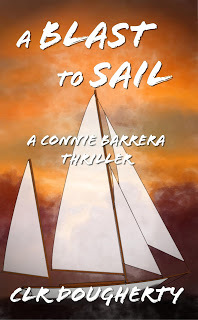 Available now from Amazon As we sailed north from the Norfolk area, I was finishing A Blast to Sail, the third Connie Barrera Thriller. A lot of the action in the book takes place on the Chesapeake Bay. Writing about Connie and Paul cruising on the Bay coupled with our physical presence there evoked strong feelings of nostalgia. It was tempting to dally, to revisit some of our favorite places, but I remembered the words of the policeman in West Caicos a few weeks ago. “Just stick to your mission, captain, and you’ll be okay.”
Available now from Amazon As we sailed north from the Norfolk area, I was finishing A Blast to Sail, the third Connie Barrera Thriller. A lot of the action in the book takes place on the Chesapeake Bay. Writing about Connie and Paul cruising on the Bay coupled with our physical presence there evoked strong feelings of nostalgia. It was tempting to dally, to revisit some of our favorite places, but I remembered the words of the policeman in West Caicos a few weeks ago. “Just stick to your mission, captain, and you’ll be okay.”
We were indeed on a mission, though not the one to which he had been referring. We were on our way to Annapolis, Maryland, to store the boat and buy a car; we wanted to get reacquainted with family and try living ashore in the States for a while. After living on Play Actor for 15 years, we both felt the need for a break from our life afloat.
The prospect of such a big change in our lives was exciting, but it was also frightening. We’ve visited the States several times since we took Play Actor to the islands. We’ve been shocked every time at the pace of life and the dramatic changes that have occurred during our absence, but we’ve had the comfort of knowing that we’d soon be back on the boat and living on island time again. This time, we won’t have that escape. Play Actor, our only home for the last 15 years, will be out of the water, mothballed in Annapolis, and our belongings that were aboard will go into storage with the furniture from our old life ashore.
I was able to escape into Connie’s and Paul’s adventures in A Blast to Sail, but Leslie didn’t have that option. When I finished the first draft and gave it to her to read, we were in the midst of consolidating our belongings in storage. By then, we had purchased a car and were staying in a motel in northern Virginia, commuting from the storage facility to the boat in Annapolis as we tied up loose ends.
Well before we were ready mentally, we had finished our tasks. We loaded our belongings into the car and took off, driving cross-country to California to spend some time with Leslie’s family. We would visit for a while, and then head back east to Texas to see the children and grandchildren. After that, we planned to explore some of the parts of the U.S. that we had not seen.
We were excited, but our excitement was tempered with pangs of homesickness already. The boat was no longer our refuge; it could be again someday, but not now. We had some difficulty with the idea that we didn’t have anywhere of our own to call home. Besides that, there was the shock of adjusting to life in the States.
We had just spent two months traveling almost three thousand miles on Play Actor, moving little faster than the pace of a brisk walk. Now we were driving at 80 miles an hour in the slow lane on the Interstate. We covered the next three thousand miles of our journey in four days. We’re still reeling from the change of pace.
We’re in California with Leslie’s parents. I’ve published A Blast to Sail, and we’re coming to grips with the notion that home is just a metaphysical construct. It’s an idea, not a concrete place. It's certainly not Play Actor, as she sits high, dry, and empty in a boatyard on the other side of the country. But part of me is already back in the islands with Dani and Liz as I listen to them shape their next adventure. While I write their ninth Bluewater Thriller, I’ll be living in the islands on Vengeance. It’s the next best thing to being there.
 Available now from Amazon As we sailed north from the Norfolk area, I was finishing A Blast to Sail, the third Connie Barrera Thriller. A lot of the action in the book takes place on the Chesapeake Bay. Writing about Connie and Paul cruising on the Bay coupled with our physical presence there evoked strong feelings of nostalgia. It was tempting to dally, to revisit some of our favorite places, but I remembered the words of the policeman in West Caicos a few weeks ago. “Just stick to your mission, captain, and you’ll be okay.”
Available now from Amazon As we sailed north from the Norfolk area, I was finishing A Blast to Sail, the third Connie Barrera Thriller. A lot of the action in the book takes place on the Chesapeake Bay. Writing about Connie and Paul cruising on the Bay coupled with our physical presence there evoked strong feelings of nostalgia. It was tempting to dally, to revisit some of our favorite places, but I remembered the words of the policeman in West Caicos a few weeks ago. “Just stick to your mission, captain, and you’ll be okay.”We were indeed on a mission, though not the one to which he had been referring. We were on our way to Annapolis, Maryland, to store the boat and buy a car; we wanted to get reacquainted with family and try living ashore in the States for a while. After living on Play Actor for 15 years, we both felt the need for a break from our life afloat.
The prospect of such a big change in our lives was exciting, but it was also frightening. We’ve visited the States several times since we took Play Actor to the islands. We’ve been shocked every time at the pace of life and the dramatic changes that have occurred during our absence, but we’ve had the comfort of knowing that we’d soon be back on the boat and living on island time again. This time, we won’t have that escape. Play Actor, our only home for the last 15 years, will be out of the water, mothballed in Annapolis, and our belongings that were aboard will go into storage with the furniture from our old life ashore.
I was able to escape into Connie’s and Paul’s adventures in A Blast to Sail, but Leslie didn’t have that option. When I finished the first draft and gave it to her to read, we were in the midst of consolidating our belongings in storage. By then, we had purchased a car and were staying in a motel in northern Virginia, commuting from the storage facility to the boat in Annapolis as we tied up loose ends.
Well before we were ready mentally, we had finished our tasks. We loaded our belongings into the car and took off, driving cross-country to California to spend some time with Leslie’s family. We would visit for a while, and then head back east to Texas to see the children and grandchildren. After that, we planned to explore some of the parts of the U.S. that we had not seen.
We were excited, but our excitement was tempered with pangs of homesickness already. The boat was no longer our refuge; it could be again someday, but not now. We had some difficulty with the idea that we didn’t have anywhere of our own to call home. Besides that, there was the shock of adjusting to life in the States.
We had just spent two months traveling almost three thousand miles on Play Actor, moving little faster than the pace of a brisk walk. Now we were driving at 80 miles an hour in the slow lane on the Interstate. We covered the next three thousand miles of our journey in four days. We’re still reeling from the change of pace.
We’re in California with Leslie’s parents. I’ve published A Blast to Sail, and we’re coming to grips with the notion that home is just a metaphysical construct. It’s an idea, not a concrete place. It's certainly not Play Actor, as she sits high, dry, and empty in a boatyard on the other side of the country. But part of me is already back in the islands with Dani and Liz as I listen to them shape their next adventure. While I write their ninth Bluewater Thriller, I’ll be living in the islands on Vengeance. It’s the next best thing to being there.
Published on July 05, 2015 21:03
June 28, 2015
Living What I Write -- Part VI
And now, the best parts of the waterway:
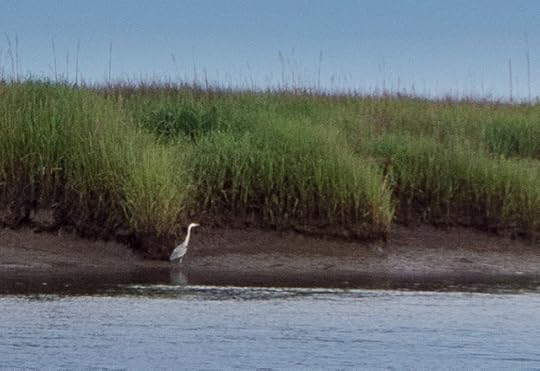 Late afternoon at Wally’s Leg off the Mackay River in south Georgia. We were isolated from civilization by miles of salt marsh. Georgia’s marshes haven’t changed much since I used to fish them with my father in the ‘50s.
Late afternoon at Wally’s Leg off the Mackay River in south Georgia. We were isolated from civilization by miles of salt marsh. Georgia’s marshes haven’t changed much since I used to fish them with my father in the ‘50s.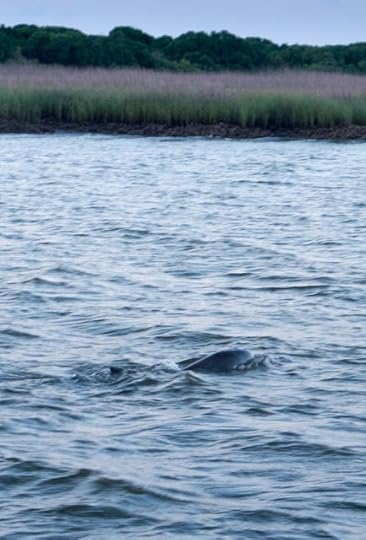 A neighbor came calling during cocktail hour in Awendaw Creek, in South Carolina’s Cape Romaine Wildlife Refuge. This dolphin and several others dropped by to say hello as we were anchoring.
A neighbor came calling during cocktail hour in Awendaw Creek, in South Carolina’s Cape Romaine Wildlife Refuge. This dolphin and several others dropped by to say hello as we were anchoring.One evening years ago, Leslie and I were anchored in this spot at low tide, and we gathered enough fresh oysters from public oyster beds for dinner. The beds are closed now; back then they were open for recreational harvesting.
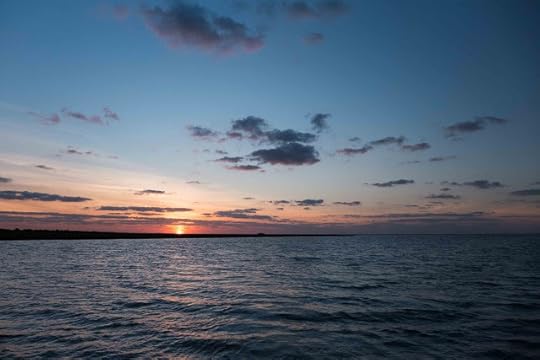
Sunrise over the marsh the next morning at Awendaw Creek as we raised our anchor -- the beginning of another beautiful day in the low country.

Cowhouse Creek, off the Waccamaw River in South Carolina.
Incredibly, this is only a few miles south of the out-of-control development in the Myrtle Beach area.
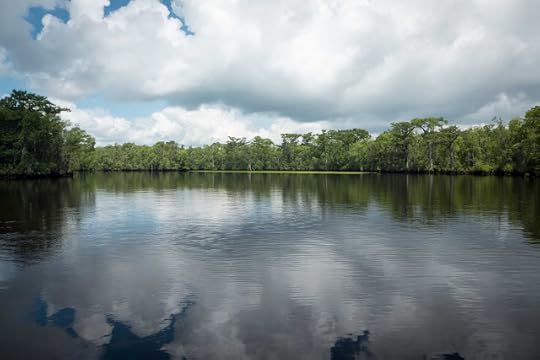
A couple of hours north of Cowhouse Creek, we stopped in another favorite spot on the Waccamaw. This oxbow is near Enterprise Landing, even closer to Myrtle Beach. Over the years, we spent many nights here in solitude, listening to alligators and bullfrogs at night and woodpeckers during the day. We were sad to see the beginnings of a gated community on the opposite bank of the Waccamaw.
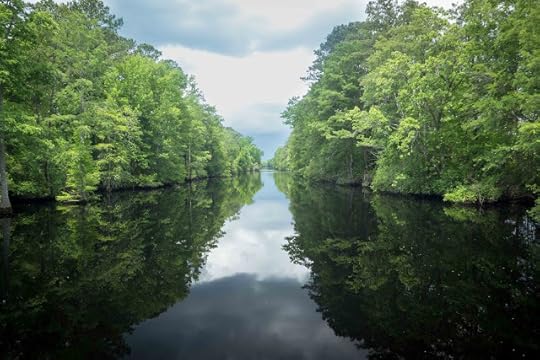
Early morning on the Dismal Swamp Canal, near the state line between North Carolina and Virginia.
George Washington surveyed the route for the canal through the Great Dismal Swamp before the Revolutionary War, and he was one of the shareholders in the company that built it. The company was formed in 1784, and construction started in 1793.
Opened in 1805, the canal carried commercial traffic between Virginia’s Tidewater and the Albemarle region of North Carolina. By the early 20th century, other forms of transportation diminished the commercial importance of the canal. Today, it’s maintained by the U.S. Army Corps of Engineers and is used primarily for recreational traffic. We’ve traversed it many times, always amazed at the natural beauty, even though we see a highway paralleling our course a few yards to the east through the trees.
We'll be in Hampton, Virginia tonight, where we'll meet some friends who live in Suffolk, not far from the canal. We're debating whether to sail straight from Hampton to our destination in Annapolis or take several days, working our way up the Chesapeake. Both are tempting; it's a 20-hour run up the center of the Bay to Annapolis, but there are lots of pretty places to stop along the way. In our years of cruising the Chesapeake, we've enjoyed both options several times. We'll see how we feel after a day in Hampton.
Published on June 28, 2015 10:50
June 22, 2015
Living What I Write - Part V
North up the Atlantic Intracoastal Waterway
“Do you think we should wait on a decent forecast and then run up the Gulf Stream to Beaufort?” Leslie asked, as we flew our sails at anchor to dry them out before we put them away.
“I don’t trust the stern rail for another offshore passage,” I said. “I vote for going up the waterway to Vero Beach. I can get some U-bolts there and try to patch it together."
Vero Beach is a convenient spot to regroup. The municipal marina is right on the bus route, so it’s easy to get around town to find things.
“We’ve never been up that stretch,” Leslie said. “Let’s do it. Besides, the weather doesn’t matter if we’re in the ditch."
 Miami
Miami
We left Miami the next morning. The waterway’s route through the northern parts of Miami was far more attractive than we expected, with wide open vistas and interesting homes. As we got closer to Fort Lauderdale, we had the sense that we were sailing through the streets of a city, with towering apartment buildings perched on the edges of a narrow, dredged channel. We were truly in a ditch, or a concrete canyon.
We lost count of the drawbridges between Miami and Palm Beach. Most of them opened on restricted schedules, and we lost hours of travel time waiting for them. We made it into South Lake Worth shortly after dark and anchored for the night.
The next morning, we went in search of diesel fuel, as we were running low. We were surprised at how few places sold fuel, given the large number of boats. We managed to find a place and filled the tank. Of course, once we had our fuel, there were fuel docks every few miles as we worked our way north, still dealing with bridge restrictions. At least the scenery got better the farther north we got.
North of Lake Worth, we were no longer in new territory, and we amused ourselves by remembering how the shoreline had looked 12 to 15 years ago. We anchored just south of the Fort Pierce inlet in a spot that we knew from years ago. We were surprised to see an endless condo development on islands that had been covered with scrub mangrove when we were here last. The islands were built up from dredged spoils; we were surprised the filled land would support multi-story buildings.
We had a three-hour run to Vero Beach the next morning and found the marina much as we remembered it. We arrived on a Sunday, so the buses weren’t running. We walked a couple of miles to a grocery store that we remembered, because we were out of bread.
We were stunned at the sprawling shopping area that had grown up around what had been a small strip shopping center. The grocery store had expanded; we were overwhelmed. It comprised enough space to house the entire population of most of the islands where we’d spent the last 11 years. The stock would have fed the all the people of most of the islands for months, and there was another store just as big right down the road.
 Along a less-developed stretch - an osprey's waterfront home on a channel markerOn Monday, I found what I needed to mend the stern rail, although I still didn’t trust it offshore, so we decided to continue up the Intracoastal Waterway. Besides not having to worry about the weather, we were curious to see the rest of the ditch.
Along a less-developed stretch - an osprey's waterfront home on a channel markerOn Monday, I found what I needed to mend the stern rail, although I still didn’t trust it offshore, so we decided to continue up the Intracoastal Waterway. Besides not having to worry about the weather, we were curious to see the rest of the ditch.
The banks of the waterway through most of Florida are heavily developed now, and to us, unattractive. The residences range from rabbit-hutch-like condos to mansions. A few of the single family homes weren’t bad looking, but neither of us could imagine sitting in the den of a million-dollar-plus home staring across a 100-foot-wide ditch at someone else’s backyard.
Closer to Jacksonville, the shoreline began to give way to scrub and salt marsh, and the development was farther from the waterway.
Fernandina Beach, almost on the state line with Georgia, didn’t appear to have changed much, although the depth of the Amelia River approaching Fernandina certainly had changed. It was low tide, and there wasn't enough water for our six-foot draft. We ran hard aground in the middle of the channel, in sight of the marina where we planned to stop for the night. We had the choice of calling a towboat or waiting six hours for the tide to come in. Since we had the foresight to purchase towing insurance before we left Miami, we opted for a tow. After we were floating again, I asked the towboat skipper where to find the deep water.
"Hug that eastern shore real tight," he said, "and then go around that green daymark so close you scrape the paint off the side of your boat."
We followed his instructions, finding 15 feet of water along the eastern shore. As we scraped by the green daymark, our depth sounder indicated that we were in trouble again. We came to an abrupt stop, hard aground once more. The towboat came alongside, the skipper red in the face.
"Did I misunderstand?" I asked.
"No, sir," he said. "You did just right. Reckon it's done shoaled in some more. I'm gonna get you 'round to the marina, though."
We attached the towing line to our samson post, and he pulled us off the shoal with more difficulty. True to his words, he stayed with us until we picked up a mooring at the marina, once again in deep water. He grumbled that the river had shoaled significantly in the last several years, perhaps because of all the construction in the area. The irony of this is that the inlet at Fernandina, less than a couple of miles from where we went aground, is the approach channel to the U.S. Navy's Kings Bay submarine base.
We were soon having sundowners in the cockpit, looking forward to seeing Georgia's marshlands the next day.
Next week: A few places are untouched, still.
“Do you think we should wait on a decent forecast and then run up the Gulf Stream to Beaufort?” Leslie asked, as we flew our sails at anchor to dry them out before we put them away.
“I don’t trust the stern rail for another offshore passage,” I said. “I vote for going up the waterway to Vero Beach. I can get some U-bolts there and try to patch it together."
Vero Beach is a convenient spot to regroup. The municipal marina is right on the bus route, so it’s easy to get around town to find things.
“We’ve never been up that stretch,” Leslie said. “Let’s do it. Besides, the weather doesn’t matter if we’re in the ditch."
 Miami
MiamiWe left Miami the next morning. The waterway’s route through the northern parts of Miami was far more attractive than we expected, with wide open vistas and interesting homes. As we got closer to Fort Lauderdale, we had the sense that we were sailing through the streets of a city, with towering apartment buildings perched on the edges of a narrow, dredged channel. We were truly in a ditch, or a concrete canyon.
We lost count of the drawbridges between Miami and Palm Beach. Most of them opened on restricted schedules, and we lost hours of travel time waiting for them. We made it into South Lake Worth shortly after dark and anchored for the night.
The next morning, we went in search of diesel fuel, as we were running low. We were surprised at how few places sold fuel, given the large number of boats. We managed to find a place and filled the tank. Of course, once we had our fuel, there were fuel docks every few miles as we worked our way north, still dealing with bridge restrictions. At least the scenery got better the farther north we got.
North of Lake Worth, we were no longer in new territory, and we amused ourselves by remembering how the shoreline had looked 12 to 15 years ago. We anchored just south of the Fort Pierce inlet in a spot that we knew from years ago. We were surprised to see an endless condo development on islands that had been covered with scrub mangrove when we were here last. The islands were built up from dredged spoils; we were surprised the filled land would support multi-story buildings.
We had a three-hour run to Vero Beach the next morning and found the marina much as we remembered it. We arrived on a Sunday, so the buses weren’t running. We walked a couple of miles to a grocery store that we remembered, because we were out of bread.
We were stunned at the sprawling shopping area that had grown up around what had been a small strip shopping center. The grocery store had expanded; we were overwhelmed. It comprised enough space to house the entire population of most of the islands where we’d spent the last 11 years. The stock would have fed the all the people of most of the islands for months, and there was another store just as big right down the road.
 Along a less-developed stretch - an osprey's waterfront home on a channel markerOn Monday, I found what I needed to mend the stern rail, although I still didn’t trust it offshore, so we decided to continue up the Intracoastal Waterway. Besides not having to worry about the weather, we were curious to see the rest of the ditch.
Along a less-developed stretch - an osprey's waterfront home on a channel markerOn Monday, I found what I needed to mend the stern rail, although I still didn’t trust it offshore, so we decided to continue up the Intracoastal Waterway. Besides not having to worry about the weather, we were curious to see the rest of the ditch.The banks of the waterway through most of Florida are heavily developed now, and to us, unattractive. The residences range from rabbit-hutch-like condos to mansions. A few of the single family homes weren’t bad looking, but neither of us could imagine sitting in the den of a million-dollar-plus home staring across a 100-foot-wide ditch at someone else’s backyard.
Closer to Jacksonville, the shoreline began to give way to scrub and salt marsh, and the development was farther from the waterway.
Fernandina Beach, almost on the state line with Georgia, didn’t appear to have changed much, although the depth of the Amelia River approaching Fernandina certainly had changed. It was low tide, and there wasn't enough water for our six-foot draft. We ran hard aground in the middle of the channel, in sight of the marina where we planned to stop for the night. We had the choice of calling a towboat or waiting six hours for the tide to come in. Since we had the foresight to purchase towing insurance before we left Miami, we opted for a tow. After we were floating again, I asked the towboat skipper where to find the deep water.
"Hug that eastern shore real tight," he said, "and then go around that green daymark so close you scrape the paint off the side of your boat."
We followed his instructions, finding 15 feet of water along the eastern shore. As we scraped by the green daymark, our depth sounder indicated that we were in trouble again. We came to an abrupt stop, hard aground once more. The towboat came alongside, the skipper red in the face.
"Did I misunderstand?" I asked.
"No, sir," he said. "You did just right. Reckon it's done shoaled in some more. I'm gonna get you 'round to the marina, though."
We attached the towing line to our samson post, and he pulled us off the shoal with more difficulty. True to his words, he stayed with us until we picked up a mooring at the marina, once again in deep water. He grumbled that the river had shoaled significantly in the last several years, perhaps because of all the construction in the area. The irony of this is that the inlet at Fernandina, less than a couple of miles from where we went aground, is the approach channel to the U.S. Navy's Kings Bay submarine base.
We were soon having sundowners in the cockpit, looking forward to seeing Georgia's marshlands the next day.
Next week: A few places are untouched, still.
Published on June 22, 2015 02:46
May 31, 2015
Living What I Write -- Part IV
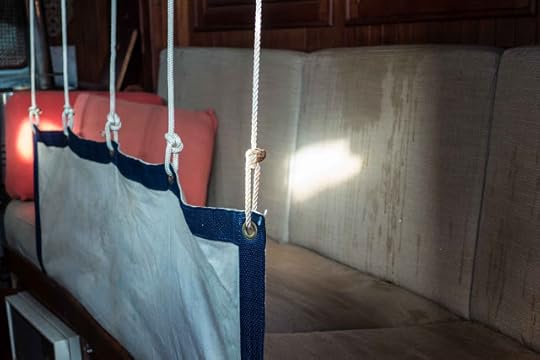 Note the waterstains on our sea berth
Note the waterstains on our sea berth“I need you on deck, Bud,” I heard through the fog of a sound sleep. I was wide awake as I scrambled out of my sea berth. My feet hit the cabin sole and I staggered to the companionway ladder as the boat crashed from wave to wave. She was rolling through about 45 degrees to each side of vertical every few seconds and plowing into steep head seas with a jarring crash in between rolls.
“What’s the matter?” I yelled up at Leslie as I struggled into my safety harness while bracing myself against the ladder. I could tell from her voice and the boat’s motion that there was some urgency, so I skipped putting on my foul weather gear. She had been on watch since on midnight, and I had been catching up on sleep. I had no idea what time it was; I felt like I had slept for days. I wondered if I had slept through the alarm. Tacking back and forth across the channel for the previous 20 hours had worn us both out.
“Wind’s piped up; I need the third reef in the main,” Leslie yelled to be heard over the howl of the wind, as I crawled out into the cockpit.
I was no sooner out than I got soaked by a boarding sea that left a foot of water swirling around in the cockpit. The water was warm, but the wind cutting through my soaked clothes felt like ice. I regretted not putting on my foul weather jacket.
While I slept, the wind had built to a steady 30 knots, gusting higher, and the seas were sloppy. The boat was overpowered, and we had tied in the second reef when the squalls started a day ago.
I clipped a tether onto my harness to keep me connected to the boat in case I fell overboard and made my way to the mast. Hanging on as I struggled with wet lines and flogging canvas, I tied in the third reef, reducing the mainsail to a fraction of its full size.
The boat stood up a bit straighter and the wild motion moderated. I sat in the cockpit shivering from the wind chill until I was sure Leslie was satisfied with our sail trim.
“That feels good,” she said, after a minute or two. “We’ve sped up almost a knot, now that she’s not rail down, and the helm’s balanced again."
“Good,” I nodded. “What time is it?"
“Almost one."
I had only been asleep for an hour. “You okay?” I asked.
“Yes. Go back to sleep. See you at four o’clock."
When I came on watch at four, we were still sailing well with the reefed main and the staysail. I plotted our position before I went on deck; we had averaged almost six knots and were right on course. I put on my foul weather gear and my harness and crawled into the cockpit, slipping behind the helm.
Leslie went below and fixed me a cup of coffee before she crashed. By the time she woke up and came on deck to relieve me at 8 a.m., the wind had moderated a bit. We discussed shaking out the third reef. As we were both still tired and our speed was above 5 knots, we decided not to do it. I went below and went to sleep.
At nine a.m., Leslie called me again. The wind had built to over thirty-five knots, and it was gusting well over 45 knots in frequent squalls. We already had the third reef in the main, and the boat was overpowered again. We dropped the staysail and decided to heave to under the main while we changed headsails.
While Leslie lashed the staysail out of the way along the lifelines on the foredeck, I brought up our storm jib. It’s tiny and made from extra heavy sailcloth. We hanked it on the inner forestay and raised it. Properly canvassed for the conditions, we were still making good time, given the sea state and the opposing current.
After 24 hours, we rounded the southwestern corner of the Bahama Bank and entered the Santaren Channel, which would take us between the Bahama Bank and the Cay Sal Bank to the Straits of Florida. Our course was now a straight line north-northwest to Miami, and we would begin to pick up a favorable current from the Gulf Stream in 15 or 20 hours as we cleared the Cay Sal Bank.
Conditions were still sloppy in the Santaren Channel, although most of the squalls had passed. We had steady northeast winds of 30 to 35 knots, with occasional gusts into the 40s. We were not looking forward to being in the Gulf Stream with this wind; it would be blowing against the current, raising steep, high, short-interval seas. We resigned ourselves to a rough passage.
To add to our anxiety, some welds in our stern rail had cracked in the violent seas. The stern rail supports our rowing dinghy’s davits, and it’s where we carry the outboard for our rigid inflatable dinghy. I lashed the rail together with a dock line, and we kept an eye on it.
I decided that if another weld broke, we would have to jetison both the rowing dinghy and the outboard. If the stern rail went, it would take our lifelines with it, increasing the risk of one of us falling overboard.
As we got closer to the Gulf Stream, we were able to pick up the NOAA weather broadcasts on VHF radio. The forecast was grim, from our perspective. They were issuing hazardous condition warnings for the Gulf Stream.
Our options were limited. We could heave to and wait a day or two in the Santaren Channel, which wasn’t a pleasant prospect, or we could go on and endure another day of yet rougher seas. We opted for the latter.
By the time we reached the Gulf Stream, our decks had been flooded more or less constantly for over 24 hours, and we were discovering a myriad of annoying leaks. These were no threat to the vessel; there wasn’t much water coming in, but it soaked our sea berth, so we were sleeping curled up in the nav station seat. Most of our belongings that weren’t sealed in plastic were wet.
The stormy weather continued until we were about thirty miles southeast of Miami. A Coastguard patrol plane buzzed us there, yelling something on a loud hailer, but we couldn’t make out what they said. Our radio was on, but we were both on deck and couldn’t hear it, so we didn’t know if they tried to call us. The plane circled once and flew away. Our guess is they were responding to a distress call from another vessel and recognized that we we not their quarry.
At sundown, we had the Miami skyline well in sight. The wind dropped to nothing, as if someone had switched it off. We started the engine and motored into the ship channel, turning up into the Intracoastal Waterway at Watson Island. We were in familiar territory.
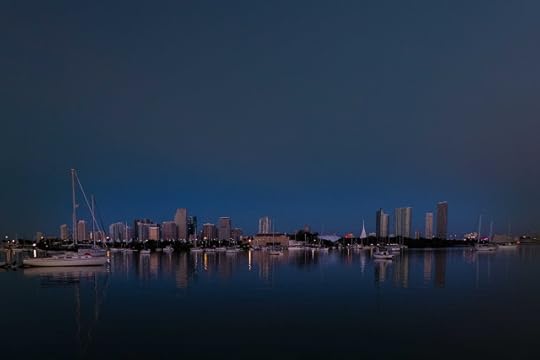 The anchorage off the Miami Yacht Club at night.Before we sailed to the Caribbean years ago, we spent a lot of time in this area during the winter months. We were once members of the Miami Yacht Club, which is on the east side of Watson Island. We left the waterway and felt our way through the shallows south of the Venetian Causeway and found a spot to anchor off the yacht club. We didn’t plan to go ashore, but we were going to rest and dry the boat out before we went on.
The anchorage off the Miami Yacht Club at night.Before we sailed to the Caribbean years ago, we spent a lot of time in this area during the winter months. We were once members of the Miami Yacht Club, which is on the east side of Watson Island. We left the waterway and felt our way through the shallows south of the Venetian Causeway and found a spot to anchor off the yacht club. We didn’t plan to go ashore, but we were going to rest and dry the boat out before we went on.Next week: Licking our wounds and moving north.
Published on May 31, 2015 16:11
May 24, 2015
Living What I Write - Part III
“I’m excited about taking the Old Bahama Channel route,” Leslie said, after I raised the anchor.
“Because we haven’t done it before?” I asked.
“That, plus we can sail straight through to Florida. I wasn’t looking forward to island hopping through the Bahamas. Been there, done that.”
"Well, once we're past Great Inagua, we're committed. There's nowhere to stop for 600 miles," I said.
"Nothing to it," she said. "Five or six days -- we're already in the rhythm of standing watches."
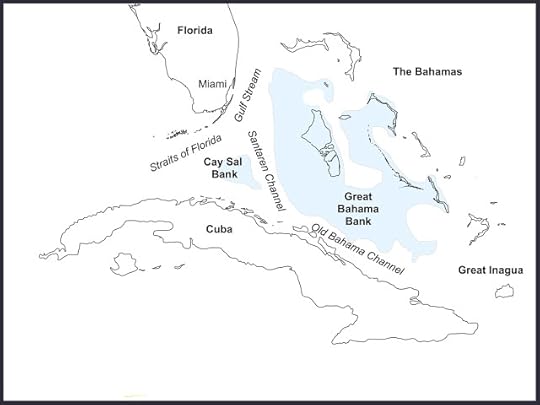 We left West Caicos on Tuesday morning with a light easterly wind. It was blowing less than ten knots. That's enough wind to move the boat, but not enough to make good speed, since it was directly behind us. Our expectation was that it was the precursor to the return of the easterly trade winds.
We left West Caicos on Tuesday morning with a light easterly wind. It was blowing less than ten knots. That's enough wind to move the boat, but not enough to make good speed, since it was directly behind us. Our expectation was that it was the precursor to the return of the easterly trade winds.
Motorsailing in the light air, we set a course to Great Inagua, the southernmost of the Bahama Islands. It’s an isolated island roughly midway between the Caicos Bank and Cuba. We thought we could wait there for more wind unless the wind built while we were en route. We needed to hoard our diesel fuel this early in such a long trip; there are no fuel docks at sea and we only carry enough to cover about 500 miles at best.
After two hours, the wind had filled in to around twelve knots, and we shut down the engine. We weren’t going very fast, but we were making progress toward our destination. By sunset, Great Inagua was off our port beam, and we decided not to stop. We sailed through the evening at three to four knots, enjoying being under way and at sea again.
We had a peaceful night, and by morning, there was enough wind so that we dropped the Yankee jib, the larger of our two headsails. We were making a comfortable five knots, congratulating ourselves on our decision to take this route instead of going north through the Bahamas. We knew from the offshore weather broadcasts that a cold front had come off the Florida coast and was making things rough and unpleasant in the central Bahamas.
By noon, the wind died. Using our high frequency radio system, I downloaded weather fax charts from NOAA. We could see that there was wind in the Old Bahama Channel, not too far ahead of us. We decided to burn some of our precious diesel fuel. By the time we reached Diamond Point, the southern tip of the Great Bahama Bank, we realized that the cold front had moved much farther south than expected.
When we reached the Old Bahama Channel, we were into the weather pattern that’s typical of a frontal passage. It was cold; the sky was gray and cloudy. There were thunderstorms, and the wind was blowing hard from the northwest. This kind of weather is not normal this far south, even in mid-winter, but it’s almost unheard of in May. Climate change? Maybe so; it’s having a personal impact on us, anyway.
Not only did we have 20 plus knots of wind in our faces, but it enhanced the normal foul current in the 10 mile wide channel between Cuba and the Bahama Bank. We had a three knot current opposing us. Our nominal speed under typical conditions is 5 or 6 knots; we were unable to make progress in the direction we wanted to go. Even with the engine running, we could only make two or three knots along our course. We would have run out of diesel fuel long before we made it to Florida. Under sail alone, we were losing ground.
We decided to heave to, which gave us an easy ride in the sloppy conditions, but we were making three to four knots in the wrong direction. We reduced sail by taking a second reef in the main to cope with the gusts in the thunderstorms and started sailing again. We were beating back and forth across the channel, dodging freighters which were likewise trying to wait out this odd weather.
This tactic worked well enough. On one tack, we gained a few miles along our course. On the other, we lost a few more than we gained. Throughout the afernoon and the night, we kept up the monotonous routine. After 20 hours, the wind clocked to the north. We had lost about 20 miles, but now we could sail. We were close hauled, sailing hard on the wind, but we were making progress again, and we knew the wind would eventually clock to the northeast.
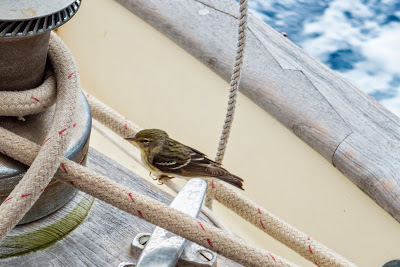 In the midst of the stormy weather, we had several bedraggled little birds land on the boat. They were blown offshore from Cuba. They would pause for an hour or two, watching us carefully, and then fly off. This one stayed for a day and half, hidden in our rowing dinghy. She came out to visit after the sun came out.
In the midst of the stormy weather, we had several bedraggled little birds land on the boat. They were blown offshore from Cuba. They would pause for an hour or two, watching us carefully, and then fly off. This one stayed for a day and half, hidden in our rowing dinghy. She came out to visit after the sun came out.
The next afternoon, the wind at last clocked to the northeast, and we had 15 to 20 knots on our beam as we took up our course. That gave us perfect sailing conditions and we began to make up lost time.
Next week: Storms at sea are part of offshore sailing.
“Because we haven’t done it before?” I asked.
“That, plus we can sail straight through to Florida. I wasn’t looking forward to island hopping through the Bahamas. Been there, done that.”
"Well, once we're past Great Inagua, we're committed. There's nowhere to stop for 600 miles," I said.
"Nothing to it," she said. "Five or six days -- we're already in the rhythm of standing watches."
 We left West Caicos on Tuesday morning with a light easterly wind. It was blowing less than ten knots. That's enough wind to move the boat, but not enough to make good speed, since it was directly behind us. Our expectation was that it was the precursor to the return of the easterly trade winds.
We left West Caicos on Tuesday morning with a light easterly wind. It was blowing less than ten knots. That's enough wind to move the boat, but not enough to make good speed, since it was directly behind us. Our expectation was that it was the precursor to the return of the easterly trade winds.Motorsailing in the light air, we set a course to Great Inagua, the southernmost of the Bahama Islands. It’s an isolated island roughly midway between the Caicos Bank and Cuba. We thought we could wait there for more wind unless the wind built while we were en route. We needed to hoard our diesel fuel this early in such a long trip; there are no fuel docks at sea and we only carry enough to cover about 500 miles at best.
After two hours, the wind had filled in to around twelve knots, and we shut down the engine. We weren’t going very fast, but we were making progress toward our destination. By sunset, Great Inagua was off our port beam, and we decided not to stop. We sailed through the evening at three to four knots, enjoying being under way and at sea again.
We had a peaceful night, and by morning, there was enough wind so that we dropped the Yankee jib, the larger of our two headsails. We were making a comfortable five knots, congratulating ourselves on our decision to take this route instead of going north through the Bahamas. We knew from the offshore weather broadcasts that a cold front had come off the Florida coast and was making things rough and unpleasant in the central Bahamas.
By noon, the wind died. Using our high frequency radio system, I downloaded weather fax charts from NOAA. We could see that there was wind in the Old Bahama Channel, not too far ahead of us. We decided to burn some of our precious diesel fuel. By the time we reached Diamond Point, the southern tip of the Great Bahama Bank, we realized that the cold front had moved much farther south than expected.
When we reached the Old Bahama Channel, we were into the weather pattern that’s typical of a frontal passage. It was cold; the sky was gray and cloudy. There were thunderstorms, and the wind was blowing hard from the northwest. This kind of weather is not normal this far south, even in mid-winter, but it’s almost unheard of in May. Climate change? Maybe so; it’s having a personal impact on us, anyway.
Not only did we have 20 plus knots of wind in our faces, but it enhanced the normal foul current in the 10 mile wide channel between Cuba and the Bahama Bank. We had a three knot current opposing us. Our nominal speed under typical conditions is 5 or 6 knots; we were unable to make progress in the direction we wanted to go. Even with the engine running, we could only make two or three knots along our course. We would have run out of diesel fuel long before we made it to Florida. Under sail alone, we were losing ground.
We decided to heave to, which gave us an easy ride in the sloppy conditions, but we were making three to four knots in the wrong direction. We reduced sail by taking a second reef in the main to cope with the gusts in the thunderstorms and started sailing again. We were beating back and forth across the channel, dodging freighters which were likewise trying to wait out this odd weather.
This tactic worked well enough. On one tack, we gained a few miles along our course. On the other, we lost a few more than we gained. Throughout the afernoon and the night, we kept up the monotonous routine. After 20 hours, the wind clocked to the north. We had lost about 20 miles, but now we could sail. We were close hauled, sailing hard on the wind, but we were making progress again, and we knew the wind would eventually clock to the northeast.
 In the midst of the stormy weather, we had several bedraggled little birds land on the boat. They were blown offshore from Cuba. They would pause for an hour or two, watching us carefully, and then fly off. This one stayed for a day and half, hidden in our rowing dinghy. She came out to visit after the sun came out.
In the midst of the stormy weather, we had several bedraggled little birds land on the boat. They were blown offshore from Cuba. They would pause for an hour or two, watching us carefully, and then fly off. This one stayed for a day and half, hidden in our rowing dinghy. She came out to visit after the sun came out.The next afternoon, the wind at last clocked to the northeast, and we had 15 to 20 knots on our beam as we took up our course. That gave us perfect sailing conditions and we began to make up lost time.
Next week: Storms at sea are part of offshore sailing.
Published on May 24, 2015 16:49
May 17, 2015
Living what I write - Part II
The US Virgin Islands
 Cruz Bay, St. John"Welcome back to the United States," the customs officer said.
Cruz Bay, St. John"Welcome back to the United States," the customs officer said.
We were completing our clearance paperwork in St. John, a few hours after the storm I described in the last post.
"Are we really back?" I asked. "Do we have to clear in again when we get back to the States?"
"Only if you stop in a foreign country," he said. "You're home now."
"Thanks!" We both said.
I had no idea how good that would feel. I traveled a lot internationally before we ran away to sea, but that wasn't the same. It's been over ten years since Play Actor has been in U.S. waters, and she's our home. We've flown back to the States to visit several times during that period, but every time we knew that we were just visiting. When we were in the States, we felt the pull of home. For us, that was wherever we left Play Actor.
This time, we really felt like the U.S. was our home again. We decided we would not visit another foreign country before we got back to the U.S. mainland. We spent a couple of days in St. John, taking walks in the vicinity of Cruz Bay. We couldn't see much change from our last visit ten years ago. We felt the urge to move on.
 Play Actor is the little, dark boat behind the cruise ship.After a short sail in protected water, we dropped our anchor in Charlotte Amalie, St. Thomas, a few hundred yards from the cruise ship dock. We found some marine supplies that we needed and bought a few more groceries, committed to the notion that we were going back to the States without clearing into another country.
Play Actor is the little, dark boat behind the cruise ship.After a short sail in protected water, we dropped our anchor in Charlotte Amalie, St. Thomas, a few hundred yards from the cruise ship dock. We found some marine supplies that we needed and bought a few more groceries, committed to the notion that we were going back to the States without clearing into another country.
Puerto Rico
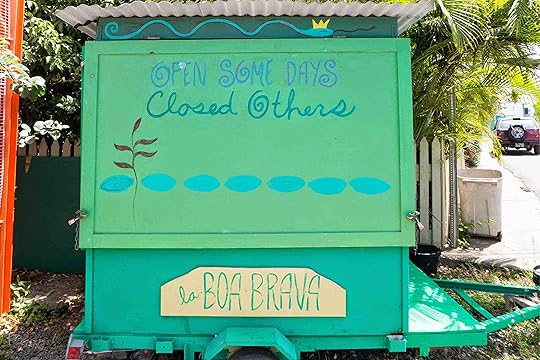 Business in Culebra gives new meaning to the phrase 'laid back.'After a day of rest watching the cruise ships come and go in Charlotte Amalie, we took a 30-mile sail to Culebra, one of Puerto Rico's coastal islands. Puerto Rico was new territory for us. We spent a day anchored in Culebra's Ensenada Honda, and then sailed a few hours to the west coast of Vieques, the other large island off Puerto Rico's east coast. We anchored off a beautiful, deserted beach for the night, enjoying the solitude.
Business in Culebra gives new meaning to the phrase 'laid back.'After a day of rest watching the cruise ships come and go in Charlotte Amalie, we took a 30-mile sail to Culebra, one of Puerto Rico's coastal islands. Puerto Rico was new territory for us. We spent a day anchored in Culebra's Ensenada Honda, and then sailed a few hours to the west coast of Vieques, the other large island off Puerto Rico's east coast. We anchored off a beautiful, deserted beach for the night, enjoying the solitude.
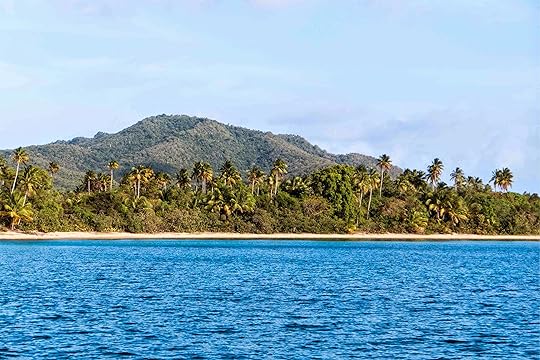 Our beach in ViequesThe next morning, we made the first of a series of short trips, each roughly thirty miles, hopping along Puerto Rico's south coast. After four overnight stops along the south coast, we rounded Cabo Rojo on the southeastern corner of Puerto Rico. We stopped for a night in Boqueron, on the west coast, and then sailed a few miles north to a charming little fishing harbor called Puerto Real. We did some last minute grocery shopping there and filled our diesel and water tanks, expecting that we would be sailing straight through from there to Florida, a distance of around 700 miles.
Our beach in ViequesThe next morning, we made the first of a series of short trips, each roughly thirty miles, hopping along Puerto Rico's south coast. After four overnight stops along the south coast, we rounded Cabo Rojo on the southeastern corner of Puerto Rico. We stopped for a night in Boqueron, on the west coast, and then sailed a few miles north to a charming little fishing harbor called Puerto Real. We did some last minute grocery shopping there and filled our diesel and water tanks, expecting that we would be sailing straight through from there to Florida, a distance of around 700 miles.
 Sunset in Boqueron
Sunset in Boqueron
The Turks and Caicos - an unplanned stop and an encounter with the authorities
We waited a few days for a favorable weather forecast and left Puerto Real, setting a course that would take us north of Hispañola and south of the Turks and Caicos into the southern Bahamas. We didn't plan to stop until we reached Florida, but we could sail through the Bahamas, anchoring for a night if we got tired.
 Clear water in West Caicos. That's our anchor chain on the bottom, 25 feet under the surface.The wind died along the south edge of the Caicos Bank, so we found a spot to anchor on the east side of West Caicos, a tiny, uninhabited island out of sight of the other islands that make up the country of the Turks and Caicos. We had come almost 400 miles from Puerto Real in three and a half days. We hoisted the yellow "Q," or quarantine, flag, signifying that we had not cleared into the country. The second day we were there, a police launch came alongside. The blast of their siren brought us on deck.
Clear water in West Caicos. That's our anchor chain on the bottom, 25 feet under the surface.The wind died along the south edge of the Caicos Bank, so we found a spot to anchor on the east side of West Caicos, a tiny, uninhabited island out of sight of the other islands that make up the country of the Turks and Caicos. We had come almost 400 miles from Puerto Real in three and a half days. We hoisted the yellow "Q," or quarantine, flag, signifying that we had not cleared into the country. The second day we were there, a police launch came alongside. The blast of their siren brought us on deck.
"Good afternoon," I said, giving them a wave.
"Good afternoon, captain," the senior of the three officers aboard said. “Our radar station saw you enter our waters yesterday and stop. What are you doing, and what are your intentions?"
"We're becalmed, waiting for wind."
"What was your last port of call?"
"St. John, U.S. Virgin Islands," I said.
“You have an outbound clearance from St. John?” he asked.
“No. It’s not required for a U.S. flagged vessel leaving U.S. waters bound for a U.S. port."
"Where are you bound?"
"Florida, via the Old Bahama Channel." We had decided to skip the Bahamas, as the weather up there was nasty. The Old Bahama Channel runs between the north coast of Cuba and the south edge of the Bahama Bank. It committed us to sail 700 miles non-stop, but it appeared to be well south of the disturbed weather. We just needed wind.
"You are in our waters, and you have not cleared in," one of the other officers said.
"Correct. We’re flying the quarantine flag; we have no intention of going ashore. Do you want us to move on out of your waters?"
"We'd rather you clear in and visit our country," he replied, smiling.
"Do we have to clear in to wait for wind?" I asked.
"How long do you think you'll be?" the senior man asked.
"The forecast is for the trades to start blowing again on Tuesday night," I said. It was Sunday afternoon.
“Let me see your passports and the ship’s document, please."
I passed him a plastic bag with the papers. He perused them and made some notes on his clipboard.
Returning our papers, the senior man said, "You're okay, captain. Just stick to your mission."
"So we don't need to leave or clear in?"
"Just stick to your mission. If you wish to go ashore, come into Providenciales and clear in. Otherwise, you're okay."
"But you would be safer in Provo," the younger man said. "There's a nice marina there."
"Call us on channel 16 if you have any trouble," the senior man said, waving as they roared away toward Providenciales.
Late Monday afternoon, they came back to visit and verify that our plans had not changed. By mid-morning on Tuesday, we had a ten-knot easterly wind. We raised the anchor and made sail, wondering if we were being observed by the radar station as we left the Turks and Caicos.
Next week's post: Want wind? Careful what you wish for.
 Cruz Bay, St. John"Welcome back to the United States," the customs officer said.
Cruz Bay, St. John"Welcome back to the United States," the customs officer said.We were completing our clearance paperwork in St. John, a few hours after the storm I described in the last post.
"Are we really back?" I asked. "Do we have to clear in again when we get back to the States?"
"Only if you stop in a foreign country," he said. "You're home now."
"Thanks!" We both said.
I had no idea how good that would feel. I traveled a lot internationally before we ran away to sea, but that wasn't the same. It's been over ten years since Play Actor has been in U.S. waters, and she's our home. We've flown back to the States to visit several times during that period, but every time we knew that we were just visiting. When we were in the States, we felt the pull of home. For us, that was wherever we left Play Actor.
This time, we really felt like the U.S. was our home again. We decided we would not visit another foreign country before we got back to the U.S. mainland. We spent a couple of days in St. John, taking walks in the vicinity of Cruz Bay. We couldn't see much change from our last visit ten years ago. We felt the urge to move on.
 Play Actor is the little, dark boat behind the cruise ship.After a short sail in protected water, we dropped our anchor in Charlotte Amalie, St. Thomas, a few hundred yards from the cruise ship dock. We found some marine supplies that we needed and bought a few more groceries, committed to the notion that we were going back to the States without clearing into another country.
Play Actor is the little, dark boat behind the cruise ship.After a short sail in protected water, we dropped our anchor in Charlotte Amalie, St. Thomas, a few hundred yards from the cruise ship dock. We found some marine supplies that we needed and bought a few more groceries, committed to the notion that we were going back to the States without clearing into another country.Puerto Rico
 Business in Culebra gives new meaning to the phrase 'laid back.'After a day of rest watching the cruise ships come and go in Charlotte Amalie, we took a 30-mile sail to Culebra, one of Puerto Rico's coastal islands. Puerto Rico was new territory for us. We spent a day anchored in Culebra's Ensenada Honda, and then sailed a few hours to the west coast of Vieques, the other large island off Puerto Rico's east coast. We anchored off a beautiful, deserted beach for the night, enjoying the solitude.
Business in Culebra gives new meaning to the phrase 'laid back.'After a day of rest watching the cruise ships come and go in Charlotte Amalie, we took a 30-mile sail to Culebra, one of Puerto Rico's coastal islands. Puerto Rico was new territory for us. We spent a day anchored in Culebra's Ensenada Honda, and then sailed a few hours to the west coast of Vieques, the other large island off Puerto Rico's east coast. We anchored off a beautiful, deserted beach for the night, enjoying the solitude. Our beach in ViequesThe next morning, we made the first of a series of short trips, each roughly thirty miles, hopping along Puerto Rico's south coast. After four overnight stops along the south coast, we rounded Cabo Rojo on the southeastern corner of Puerto Rico. We stopped for a night in Boqueron, on the west coast, and then sailed a few miles north to a charming little fishing harbor called Puerto Real. We did some last minute grocery shopping there and filled our diesel and water tanks, expecting that we would be sailing straight through from there to Florida, a distance of around 700 miles.
Our beach in ViequesThe next morning, we made the first of a series of short trips, each roughly thirty miles, hopping along Puerto Rico's south coast. After four overnight stops along the south coast, we rounded Cabo Rojo on the southeastern corner of Puerto Rico. We stopped for a night in Boqueron, on the west coast, and then sailed a few miles north to a charming little fishing harbor called Puerto Real. We did some last minute grocery shopping there and filled our diesel and water tanks, expecting that we would be sailing straight through from there to Florida, a distance of around 700 miles.  Sunset in Boqueron
Sunset in Boqueron
The Turks and Caicos - an unplanned stop and an encounter with the authorities
We waited a few days for a favorable weather forecast and left Puerto Real, setting a course that would take us north of Hispañola and south of the Turks and Caicos into the southern Bahamas. We didn't plan to stop until we reached Florida, but we could sail through the Bahamas, anchoring for a night if we got tired.
 Clear water in West Caicos. That's our anchor chain on the bottom, 25 feet under the surface.The wind died along the south edge of the Caicos Bank, so we found a spot to anchor on the east side of West Caicos, a tiny, uninhabited island out of sight of the other islands that make up the country of the Turks and Caicos. We had come almost 400 miles from Puerto Real in three and a half days. We hoisted the yellow "Q," or quarantine, flag, signifying that we had not cleared into the country. The second day we were there, a police launch came alongside. The blast of their siren brought us on deck.
Clear water in West Caicos. That's our anchor chain on the bottom, 25 feet under the surface.The wind died along the south edge of the Caicos Bank, so we found a spot to anchor on the east side of West Caicos, a tiny, uninhabited island out of sight of the other islands that make up the country of the Turks and Caicos. We had come almost 400 miles from Puerto Real in three and a half days. We hoisted the yellow "Q," or quarantine, flag, signifying that we had not cleared into the country. The second day we were there, a police launch came alongside. The blast of their siren brought us on deck."Good afternoon," I said, giving them a wave.
"Good afternoon, captain," the senior of the three officers aboard said. “Our radar station saw you enter our waters yesterday and stop. What are you doing, and what are your intentions?"
"We're becalmed, waiting for wind."
"What was your last port of call?"
"St. John, U.S. Virgin Islands," I said.
“You have an outbound clearance from St. John?” he asked.
“No. It’s not required for a U.S. flagged vessel leaving U.S. waters bound for a U.S. port."
"Where are you bound?"
"Florida, via the Old Bahama Channel." We had decided to skip the Bahamas, as the weather up there was nasty. The Old Bahama Channel runs between the north coast of Cuba and the south edge of the Bahama Bank. It committed us to sail 700 miles non-stop, but it appeared to be well south of the disturbed weather. We just needed wind.
"You are in our waters, and you have not cleared in," one of the other officers said.
"Correct. We’re flying the quarantine flag; we have no intention of going ashore. Do you want us to move on out of your waters?"
"We'd rather you clear in and visit our country," he replied, smiling.
"Do we have to clear in to wait for wind?" I asked.
"How long do you think you'll be?" the senior man asked.
"The forecast is for the trades to start blowing again on Tuesday night," I said. It was Sunday afternoon.
“Let me see your passports and the ship’s document, please."
I passed him a plastic bag with the papers. He perused them and made some notes on his clipboard.
Returning our papers, the senior man said, "You're okay, captain. Just stick to your mission."
"So we don't need to leave or clear in?"
"Just stick to your mission. If you wish to go ashore, come into Providenciales and clear in. Otherwise, you're okay."
"But you would be safer in Provo," the younger man said. "There's a nice marina there."
"Call us on channel 16 if you have any trouble," the senior man said, waving as they roared away toward Providenciales.
Late Monday afternoon, they came back to visit and verify that our plans had not changed. By mid-morning on Tuesday, we had a ten-knot easterly wind. We raised the anchor and made sail, wondering if we were being observed by the radar station as we left the Turks and Caicos.
Next week's post: Want wind? Careful what you wish for.
Published on May 17, 2015 15:11
May 10, 2015
Living what I write
April 3, 2015
My wife was crouched at the base of Play Actor's mast during a violent squall. She was flattening our mainsail to de-power it for the high winds when there was a crack like a rifle shot and she fell backward to the wildly pitching deck. Her harness and tether kept her from going overboard, and before I could lash the helm and go to her aid, she recovered. A piece of hardware in the boom vang, the block and tackle she was using, had parted. The stainless steel had grown brittle with age. She collected the pieces and brought them back to show me.
"Now what?" she asked over the howl of the wind in the rigging.
"We either need to reef the main or drop it," I said.
It was dawn when the squall struck. We had been trading off during the night, changing watch every four hours, and after a clear, moonlit night, we were taken by surprise. With the full mainsail flying, we were overpowered as the wind piped up into the mid-30-knot range. It wasn't dangerous, at least not yet, but it was a long way from the benign sail that we'd enjoyed through the night, and we still had several hours to go before our planned landfall in St. John, U.S. Virgin Islands.
 We left St. Martin late the previous afternoon and experienced one of those aesthetic treats reserved for offshore sailors. We were out of sight of land when the sun set. There was a green flash, a rare enough phenomenon, but this one occurred as the disc of the sun sunk below the top of the clouds on the horizon. In our years sailing the tropics, we've seen our share of green flashes, but never one that happened when clouds obscured the horizon. For a moment, the clouds were glowing green, but I've never managed to get a photograph of a green flash.
We left St. Martin late the previous afternoon and experienced one of those aesthetic treats reserved for offshore sailors. We were out of sight of land when the sun set. There was a green flash, a rare enough phenomenon, but this one occurred as the disc of the sun sunk below the top of the clouds on the horizon. In our years sailing the tropics, we've seen our share of green flashes, but never one that happened when clouds obscured the horizon. For a moment, the clouds were glowing green, but I've never managed to get a photograph of a green flash.
As the sun's golden glow faded from the indigo water, the moon rose off our stern. It was a waxing moon, a day or two before full, and the sky behind us to the east was clear. As the reddish-gold highlights of sunset faded, our world turned black and white and silver. Except for two whales that breached nearby just before sunset and two cruise ships that passed us just after, we had no other company.
We spent the night sailing, in awe of our surroundings. Sailing itself is magic; harnessing the power of a steady, gentle breeze to move a boat that weighs tens of tons through such an ethereal setting is transcendent. For that night, we were the only two people in the world, and what a world it was.
The sea at night, far from land, has always been our special place, but that night will stay in our memory as one of our best. It ended as dramatically as it had begun; as the moon set off our bow, the sun rose behind us, turning shades of gray with silver highlights to dazzling flashes of gold.
Although it had been a clear night, we had a few brief, misty rain showers. They barely wet the deck, the eerie diffusion of light through the moisture-laden air adding to the sense of otherworldliness. And then, as the golden sunrise became daylight, the light northeasterly wind bought the squall. At first, we thought it was another shower, until the wind piped up.
Thirty plus knots of wind isn't rare offshore. We've sailed in that kind of wind for days at a time. This morning, though, we were tired. We had set out on a single overnight passage to begin a journey that will span the next couple of months. We had not yet settled into the rhythm of watch-keeping, so neither of us had slept during our off watches. We were tired, ready to drop the anchor and get some rest.
We could see St. John looming on the horizon through the breaks in the rain. We looked at each other, deciding whether to reduce the size of the mainsail with a reef, or just take it down. Reefing was more work, but we could keep sailing. Taking it down meant running the auxiliary engine. Looking at Leslie and raising my eyebrows, I reached for the ignition key. She nodded her agreement.
Leslie took the helm and pointed the bow into the wind, revving up the diesel, while I went forward and dropped the mainsail, wrestling the hundreds of square feet of wet, slippery sailcloth into submission and lashing it to the boom. Working one-handed, I held on to keep from being knocked down by the gyrations of Play Actor as she smashed into the waves, wind-driven spray flying, soaking me.

I'm writing this as we sit in a calm anchorage a few yards off a pristine beach south of Caneel Bay, St. John. We've already forgotten the bruises and the sore muscles. They're a small price to pay for what we had last night.
We’re taking Play Actor back to the States for the first time since 2004. It’s good to be making an extended trip for a change as opposed to the short hops between islands that we’ve done for the last ten years.
There will be more posts like this one as we refresh our acquaintance with voyaging under sail, and I expect they’ll form the basis of a third non-fiction book to complement my sailing thrillers.
My wife was crouched at the base of Play Actor's mast during a violent squall. She was flattening our mainsail to de-power it for the high winds when there was a crack like a rifle shot and she fell backward to the wildly pitching deck. Her harness and tether kept her from going overboard, and before I could lash the helm and go to her aid, she recovered. A piece of hardware in the boom vang, the block and tackle she was using, had parted. The stainless steel had grown brittle with age. She collected the pieces and brought them back to show me.
"Now what?" she asked over the howl of the wind in the rigging.
"We either need to reef the main or drop it," I said.
It was dawn when the squall struck. We had been trading off during the night, changing watch every four hours, and after a clear, moonlit night, we were taken by surprise. With the full mainsail flying, we were overpowered as the wind piped up into the mid-30-knot range. It wasn't dangerous, at least not yet, but it was a long way from the benign sail that we'd enjoyed through the night, and we still had several hours to go before our planned landfall in St. John, U.S. Virgin Islands.
 We left St. Martin late the previous afternoon and experienced one of those aesthetic treats reserved for offshore sailors. We were out of sight of land when the sun set. There was a green flash, a rare enough phenomenon, but this one occurred as the disc of the sun sunk below the top of the clouds on the horizon. In our years sailing the tropics, we've seen our share of green flashes, but never one that happened when clouds obscured the horizon. For a moment, the clouds were glowing green, but I've never managed to get a photograph of a green flash.
We left St. Martin late the previous afternoon and experienced one of those aesthetic treats reserved for offshore sailors. We were out of sight of land when the sun set. There was a green flash, a rare enough phenomenon, but this one occurred as the disc of the sun sunk below the top of the clouds on the horizon. In our years sailing the tropics, we've seen our share of green flashes, but never one that happened when clouds obscured the horizon. For a moment, the clouds were glowing green, but I've never managed to get a photograph of a green flash.As the sun's golden glow faded from the indigo water, the moon rose off our stern. It was a waxing moon, a day or two before full, and the sky behind us to the east was clear. As the reddish-gold highlights of sunset faded, our world turned black and white and silver. Except for two whales that breached nearby just before sunset and two cruise ships that passed us just after, we had no other company.
We spent the night sailing, in awe of our surroundings. Sailing itself is magic; harnessing the power of a steady, gentle breeze to move a boat that weighs tens of tons through such an ethereal setting is transcendent. For that night, we were the only two people in the world, and what a world it was.
The sea at night, far from land, has always been our special place, but that night will stay in our memory as one of our best. It ended as dramatically as it had begun; as the moon set off our bow, the sun rose behind us, turning shades of gray with silver highlights to dazzling flashes of gold.
Although it had been a clear night, we had a few brief, misty rain showers. They barely wet the deck, the eerie diffusion of light through the moisture-laden air adding to the sense of otherworldliness. And then, as the golden sunrise became daylight, the light northeasterly wind bought the squall. At first, we thought it was another shower, until the wind piped up.
Thirty plus knots of wind isn't rare offshore. We've sailed in that kind of wind for days at a time. This morning, though, we were tired. We had set out on a single overnight passage to begin a journey that will span the next couple of months. We had not yet settled into the rhythm of watch-keeping, so neither of us had slept during our off watches. We were tired, ready to drop the anchor and get some rest.
We could see St. John looming on the horizon through the breaks in the rain. We looked at each other, deciding whether to reduce the size of the mainsail with a reef, or just take it down. Reefing was more work, but we could keep sailing. Taking it down meant running the auxiliary engine. Looking at Leslie and raising my eyebrows, I reached for the ignition key. She nodded her agreement.
Leslie took the helm and pointed the bow into the wind, revving up the diesel, while I went forward and dropped the mainsail, wrestling the hundreds of square feet of wet, slippery sailcloth into submission and lashing it to the boom. Working one-handed, I held on to keep from being knocked down by the gyrations of Play Actor as she smashed into the waves, wind-driven spray flying, soaking me.

I'm writing this as we sit in a calm anchorage a few yards off a pristine beach south of Caneel Bay, St. John. We've already forgotten the bruises and the sore muscles. They're a small price to pay for what we had last night.
We’re taking Play Actor back to the States for the first time since 2004. It’s good to be making an extended trip for a change as opposed to the short hops between islands that we’ve done for the last ten years.
There will be more posts like this one as we refresh our acquaintance with voyaging under sail, and I expect they’ll form the basis of a third non-fiction book to complement my sailing thrillers.
Published on May 10, 2015 18:05
March 28, 2015
Paul Russo, a man among men ... and women
 Bud’s mixed up in an argument with Connie Barrera, and I’m staying out of their way. I’ll take advantage of their distraction to say hello. I’m Paul Russo, the first mate and chef aboard the charter yacht, Diamantista II, and Connie's fiancé.
Bud’s mixed up in an argument with Connie Barrera, and I’m staying out of their way. I’ll take advantage of their distraction to say hello. I’m Paul Russo, the first mate and chef aboard the charter yacht, Diamantista II, and Connie's fiancé.Connie and I met through mutual friends. She was a charter guest on Vengeance, the yacht run by Dani Berger and Liz Chirac. Dani’s godfather is a friend of mine. I met him when I was still a homicide detective with the Miami P.D. During the charter, Connie had stumbled into trouble with some guys who were laundering drug money and smuggling diamonds. They made the mistake of crossing Dani, and her godfather asked me to help out. The whole story’s in Bluewater Ice.
Connie had a fine time with Dani and Liz and decided to buy her own boat. The boat was easy enough, but to go into the charter business, she needed a competent chef. She’s a woman with a lot of talents, but none of them involve food preparation.
Connie isn’t a direct person; she’s manipulative. When she saw me sharing the chef's duties with Liz, she began her scheme to Shanghai me. She still has no idea that I knew she was conning me back then. Not that I was resisting, you understand. My two favorite activities are sailing and cooking.
Besides, I was enjoying Connie’s company; she’s charming. Neither of us was looking for romance; we’d both been burned a few too many times. People who venture out into tropical thunderstorms are never looking to get struck by lightning, either.
Before we got the first Diamantista to the islands, we figured out there was more to our relationship than sailing and cooking. Our early days were complicated by drug smugglers who had their own plans for Diamantista, but we got through that and decided to get married. That saga is in Love for Sail.
Our romance hasn’t been all smooth sailing and Caribbean sunsets. We’ve had our problems. There was something eating away at Connie during our second charter, the one that’s described in Sailor’s Delight. I never figured it out, but I think it had something to do with an orange thong. Whatever it was, we’re solid now, but we still have our differences.
Connie’s got a temper, if you haven’t noticed, and I’m often too quick to speak my mind. I managed to get my face slapped pretty hard in the first few pages of this current story, but I think we’re getting used to one another’s quirks.
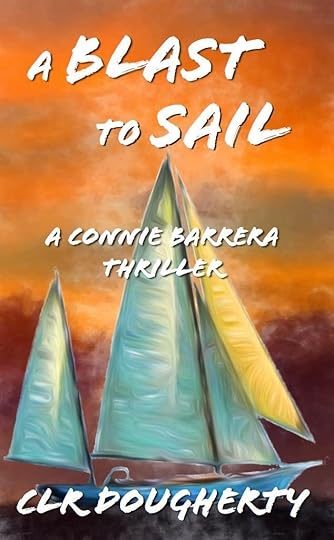 Connie and I are over halfway through our new adventure and Bud still hasn’t settled on a title for the book. Connie's annoyed with him about that. She wants to call it A Blast to Sail. She even got Liz Chirac to do a cover, but Bud’s not sold on it yet. He’ll get there, if he knows what’s good for him. I’m not getting caught between them on that.
Connie and I are over halfway through our new adventure and Bud still hasn’t settled on a title for the book. Connie's annoyed with him about that. She wants to call it A Blast to Sail. She even got Liz Chirac to do a cover, but Bud’s not sold on it yet. He’ll get there, if he knows what’s good for him. I’m not getting caught between them on that.I may get a chance for another post before this next book comes out, but Dani's waving her arms and shaking her head. I think she wants the keyboard. It’s tough sometimes, being a man in a woman’s world. Thanks for reading.
Published on March 28, 2015 13:29
March 22, 2015
A boring charter? Liz liked it.
 I know Dani said our last guests were boring. In a way, they were, but it's nice to have a charter with no stress. To me, that's the real attraction of this yachting life. Oh, there's a bit of stress in our day-to-day routine; there's the occasional bad weather or a problem with the boat.
I know Dani said our last guests were boring. In a way, they were, but it's nice to have a charter with no stress. To me, that's the real attraction of this yachting life. Oh, there's a bit of stress in our day-to-day routine; there's the occasional bad weather or a problem with the boat.There are people problems, too. Customs and immigration officers are occasionally difficult, but that’s the exception. The officials that we interact with as we move from country to country are usually pleasant, just doing their jobs. They know our visits are good for their country's economy. Most go out of their way to make us welcome, like the people here at Jolly Harbour, Antigua, who always greet us like we’re long lost relatives.
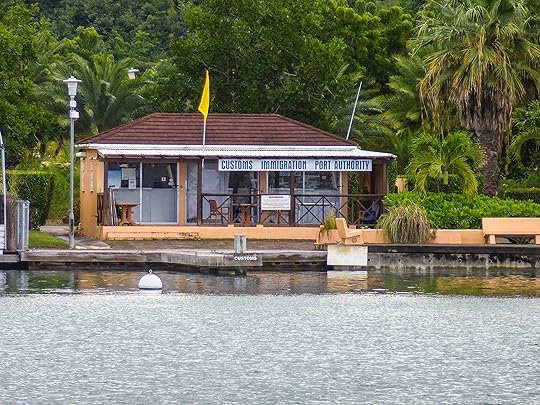
The local people are soft-spoken and considerate. They enjoy taking time out to visit, but often won’t initiate interaction for fear of intruding. While they may appear aloof, once you say hello, their reserve melts.
Our fellow yachtsmen are more likely to bring stress into our lives than the locals. Through ignorance, carelessness, or poor judgment, they sometimes do things that cause problems. Anchoring too close to us is a common failing among them. At best, that's an invasion of privacy, but when the weather turns foul in the middle of the night and their anchors drag, it can be dangerous. We've been awakened more than once by the crash of another boat dragging into us. They can be loud, too, disrupting the tranquil environment that we all sought when we came to the islands. And they’re often abrupt and in a hurry, unlike our island hosts.
Our guests are sometimes a source of stress, too. We get all kinds of people; most are nice, but there are some ... well, let's say they're different. The charter before last, the one Bud wrote about in Bluewater Rendezvous, is an example. Dani and I are still discussing Angela Cappelletti.
I think Angela was just a girl trapped in an unpleasant situation, but Dani's view is that she was a cold-blooded, conniving killer. She thinks Angela set that whole scenario in motion to get rid of her father. Then there was Carlotta Solanó. There's not much doubt about what she was, but it's interesting to look at her as Angela's alter ego, especially since they went so far as to switch identities.
Recalling that brings me to the subject of Dani and Ralph Suarez. We covered that before, at least to the point that Dani let me know she didn't want to talk about it. I know he's on her mind, though, in the odd moments when I find her staring off into the distance. Sometimes she's smiling, and sometimes she's frowning. I don't ask; she's not comfortable talking about him. That's a giveaway, in itself. After living with her for the last four years, I can tell what's on her mind. I don't think we've heard the last of that story.
Published on March 22, 2015 04:17
March 14, 2015
Dani the Peacemaker
 I knew as soon as I read Bud’s post about the Heineken Regatta that there would be trouble. Liz was in his face first thing the next morning.
I knew as soon as I read Bud’s post about the Heineken Regatta that there would be trouble. Liz was in his face first thing the next morning.“You’ve made me look like some mindless little clone who just buys expensive groceries and fritters away her time in the galley,” she said, in a hurt tone. I could hear the suppressed shriek; she’s a harpy, deep down inside, but she hides it well.
“I’m so sorry I’ve upset you,” he said, sincerity etched in the lines of his weathered face. “I didn’t mean to portray you as one of that crowd. You’re the protypical charter boat chef, Liz. They all aspire to be like you, but none of them are even in the same league. They can dress like you and act like you. A few of them may even be able to cook like you, but they can’t fool me — not really. You’re unique, and your talents and skills go far beyond what you do in the galley. You can hand, reef, and steer with the best sailors I know, and there’s nobody I’d rather have at my back when things turn rough."
Of course, I knew he would normally have added, “except Dani,” but I can understand why he didn’t. I wouldn’t cross her myself; she can be dangerous. I watched her expression soften as she listened, and the next thing I knew, they were walking away, arm in arm, going to some upscale coffee shop near the yacht club.
I’m relieved. The way she’d been carrying on with me about that post, I thought he’d have another bend in that crooked nose of his before she was done. I see now where Connie gets her smooth talk; he should have been a lawyer.
Speaking of lawyers, our current charter guests are taking an island tour today. They’re a nice enough couple, but a little on the boring side. They’re a husband and wife, partners in some real estate law practice. When we got the booking, I was hoping they were criminal lawyers — maybe with some interesting, unhappy clients who might try to ruin their vacation. No such luck.
Liz has been having a fine time keeping them amused. They’ve been snorkeling, shopping, and going to the museums. They spent one whole day walking around Pointe-à-Pitre, making pictures of the shoe stores. I’ll grant you, not many cities have streets a mile long with nothing but shoe stores, but still.
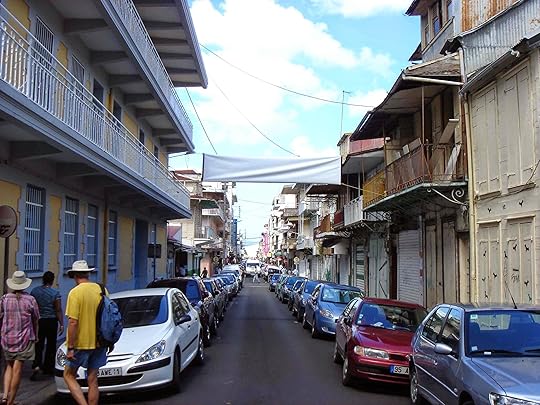
They’re easily entertained and not much trouble, but I’ve been going nuts trying to stay out of the way. I’ve done things like dive on the prop every day and polish it. I’ve spent so much time under Vengeance scraping imaginary barnacles that the fish are bringing me snacks.
Oh, well. Every charter can’t be worth a book. I hope Connie and Paul are having more excitement with their new boat. I’ll be glad when their adventure is done and I can get Bud’s devious mind focused on my needs again.
Published on March 14, 2015 13:59



